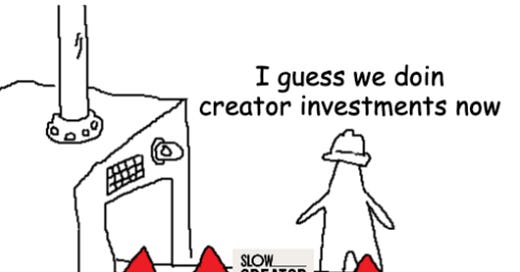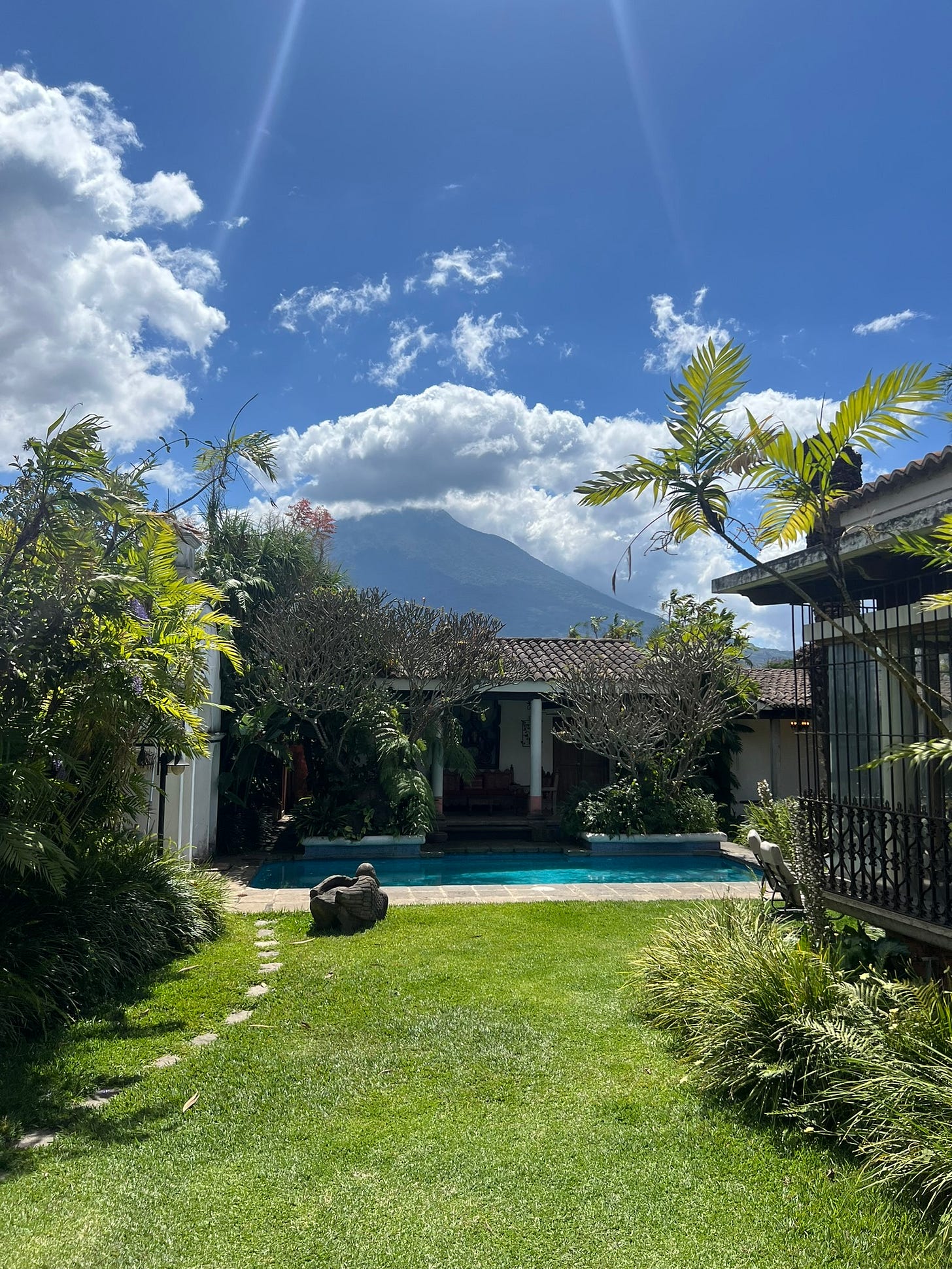Welcome to Young Money! If you’re new here, you can join the tens of thousands of subscribers receiving my essays each week by adding your email below.
Writing today’s letter from the oh-so-beautiful Antigua, Guatemala.
One of the more fun long-tail outcomes of going to business school is that you develop lasting friendships with folks from all over the world, and, as those folks get married, you have fun excuses to travel to said places all over the world. There are few experiences better than “getting the band back together,” booking an Airbnb in a foreign city with all of your friends, and spending the weekend celebrating the marriage of one of your favorite couples. Bonus points when the whole ceremony is in Spanish. Here’s to Marcos and Mariana, I wish you both a lifetime of love and happiness.
Now, on to today’s piece.
In January 2024, I was sitting in a hotel room in Houston, Texas, doom-scrolling on Twitter a few hours before a wedding, when I received a message from an investor who wanted to share some thoughts on a recent tweet of mine. After a few back-and-forth messages, he hit me with an interesting proposal:
“If you have a company for your newsletter I’d invest just to support you. I’m at _____.”
That message led to a phone call where he expressed interest in investing in “Jack Raines Inc.” Structurally, this would look like writing a check to take a stake in a holding company that my newsletter, and any future ventures, would fall under. At the time, I was flattered, but 1) I didn’t really need any outside capital, and 2) I wasn’t sure what I would have done with it had I received it.
Still, it was an interesting thought experiment. A year later, I realized that it was more than an experiment: it was foresight. But more on that in a minute.
The realization that, with a bit of distribution, you can make life-changing money creating content on the internet was the most important professional discovery of my early 20s.
When I was a college student, my idea of a “successful” career was painstakingly traditional: you graduate from school and go work for a company. You do well in that job, get promoted, and secure a pay raise. If your upward mobility stalls, you apply to new jobs that offer higher salaries, and you keep the momentum rolling. I believed that the most effective way to “make a living” was by repeatedly securing the highest attainable compensation package at Big Company Inc. as you climb the corporate hierarchy.
The problem with this model isn’t that it’s ineffective. It’s actually an incredibly effective blueprint for achieving high risk-adjusted earnings. The problem with Big Company Inc. is that, well, it’s boring.
Many jobs, especially for early-to-mid career professionals, consist of cookie cutter tasks that require you to trade your time for money, year after year, and 18 months into my corporate America tour of duty, I found this whole agreement to be a bit… underwhelming. The idea that the thing that takes up half (if not more!) of your waking hours had to be so monotonous just didn’t sit well with me.
A chance encounter around this 18 month mark showed me how online distribution could provide a much more interesting alternative to Big Company Inc., if leveraged correctly.
In August 2021, I DM’d a finance meme page, Litquidity, to see if he needed help with his newsletter. I’d just started blogging myself, and I wanted some part-time work while I was traveling around a bit before business school. It turned out that he did need some help, so I took over editorial duties and started handling some of the business operations stuff (advertiser communications, one-off sponsorship projects, etc).
My time working for Litquidity was an eye-opening bootcamp on the economics of “internet distribution.” He had leveraged his, at the time, ~700k Twitter and Instagram followers to build a newsletter with 100,000 subscribers, and that newsletter was, thanks to daily ad placements, printing cash. More than enough for its owner to comfortably leave a high-paying banking job and go all-in on the meme page-turned media company. And what began as a fairly “basic” business (free newsletter monetized through ads) grew into other revenue streams and investment opportunities, such as SPVs to invest in different private companies and launching a wellness/padel club.
But all of these opportunities were downstream of content creation and distribution.
Quality, funny, social media content led to more social media followers, which led to newsletter subscribers, which led to ad revenue. Newsletter creation and distribution brought accredited investors into the “Litquidity” ecosystem, leading to different investment opportunities.
Once I understood how the newsletter game worked, I prioritized writing and promoting my own newsletter, as well as being active on Twitter and Linkedin, thinking, at the time (when ad rates were incredibly high), that at 50k, 100k, etc subscribers, I could make $250,000+ a year in ad revenue. Monetizing distribution was my golden ticket off of the Big Company Inc. path.
Over the last 3.5 years, my “distribution,” here defined as total followers/subscribers across platforms, has grown from close-to-zero to ~70k Twitter followers, ~67k newsletter subscribers, and ~40k LinkedIn followers. While my math on my advertising revenue projections proved to be wrong (no, I did not reach that $250k a year in ad revenue. It turns out that, like any other market, advertising has bubbles, and 2021 was an ad bubble), my intuition was correct on the value of distribution. That distribution landed me a book deal, my last two jobs, and countless internet-born friendships and connections. So, yeah, distribution is valuable. But that value extends far beyond simply monetizing the content itself.
But how?
Because online distribution represents a one-to-many relationship in which a “creator” serves as a central point of trust for an audience. This distribution can increase both horizontally (total number of followers) and vertically (the trust between any one follower and the creator) over time. This “trust” is especially valuable if you’re entrepreneurial-minded, and you have something to sell.
Imagine a travel vlogger who has spent years exploring the world, leaving restaurant reviews, sleeping in hostels and five-star hotels alike, and surfing, skiing, and hiking her way around the seven continents. In that time, imagine that she has accumulated one million followers across YouTube and Instagram. Now, imagine that she launches an experiential travel agency that plans luxury and immersive multi-week vacations around the world. As soon as she announces her new venture, she will receives millions of dollars in leads, commitments, and inquiries. (Trust x reach) is a potent formula for customer acquisition.
Now, apply this same line of thinking to any “creator” who has built a large, loyal audience around a particular niche, and you’ll see that “creators” are really just entrepreneurs who have inverted the traditional “business” blueprint.
And don’t get it twisted: creating content is, at its core, an entrepreneurial pursuit. You’re creating something new, whether in written, audio, or video format, and sharing it with the world. And over time, if you’re good, you can build quite a sizable audience that trusts your thoughts and perspectives. The most talented content creators are artists with impeccable sales skills.
However, despite the inherent value of having a large, captive audience, content creators have long been discounted and misunderstood in the business world.
The label “content creator” gets a bad rap, as it conjures images of TikTok “influencers” doing voice-over dance routines in outfits that make lingerie look conservative to the tune of millions of views. So when we think about content creator monetization, our first thought is one-off brand deals where influencers shill random consumer goods with a “#ad” thrown in the caption. But this was always a shallow line of thinking.
While, yes, this is one version of content creator monetization, it’s hardly the only one, and it’s certainly not the highest-leverage one. Successful content creators with true entrepreneurial aspirations are effectively playing business on easy mode, as they solved the “where will we find our customers?” issue before even building a product. Oh, and because most content creators are bootstrapped, they tend to be cash flow positive from day one. So you have this entire class of profitable entrepreneurs with massive audiences (read: customers), and yet, because of a branding issue (content creator often carries a negative connotation), few people ever thought to ask, “Can I invest in them?”
At Slow, we think the answer to this question is a resounding “yes.”
I started working for Slow Ventures last month, and last week, we announced our $63 million Creator Fund. The TLDR: we believe that creators, and especially creators who have established themselves as domain experts in their specific niches, are really entrepreneurs with audiences, and among those entrepreneurs, there will be some compelling investment opportunities. So we’re putting our money where our mouth is, literally.
Which brings me to the full circle moment from a year ago: in 2024, someone wanted to invest in “Jack Raines Inc,” now, 12 months later, I’m the one doing the investing.
Fate loves irony.
Anyway, our process at Slow’s Creator Fund looks something like this:
We’ll invest between $1m - $3m into the creator’s holding company, which encompasses their businesses, ventures, media platforms, etc.
In exchange, we receive an equity stake (usually ~10%) and the right to follow on with capital into ventures that decide to pursue additional financing.
We invest holistically. We don’t invest in the creator’s specific projects or companies. We want to be maximally aligned with the creator in all that they do for their community.
We are passive investors. We don’t take board seats, we don’t direct how to run the company, there are no creative milestones or deliverables. This is the creator's venture and we are here to support.
And I’m very, very excited to put this creator investment thesis to work.
Maybe, when you were reading this, you thought, “He’s talking about me.” Maybe you have a massive newsletter, or podcast, or YouTube channel, and maybe you know more about your domain than business executives operating in your sector today. Maybe you’re making a decent living from ad revenue, subscriptions, Patreon, and speaking fees, but your real desire is to go big: to build your own company (or companies!) as you make the jump from “content creator” to “entrepreneur.” And you know, thanks to years of testing and iterating with different content, that you’ll be able to sell. Your only bottleneck has been capital: you need to invest more money in the business to make it work, and you can’t afford to make that jump while you’re bootstrapped.
If this is you, or if it’s someone you know, shoot me a note at Jack@slow.co. I’d love to chat.
- Jack
I appreciate reader feedback, so if you enjoyed today’s piece, let me know with a like or comment at the bottom of this page!






This is great. Can’t believe no one else really did this first. I guess I’ve seen it with YouTubers. But that’s it.
Love it. Can I still invest in Jack Raines Inc?